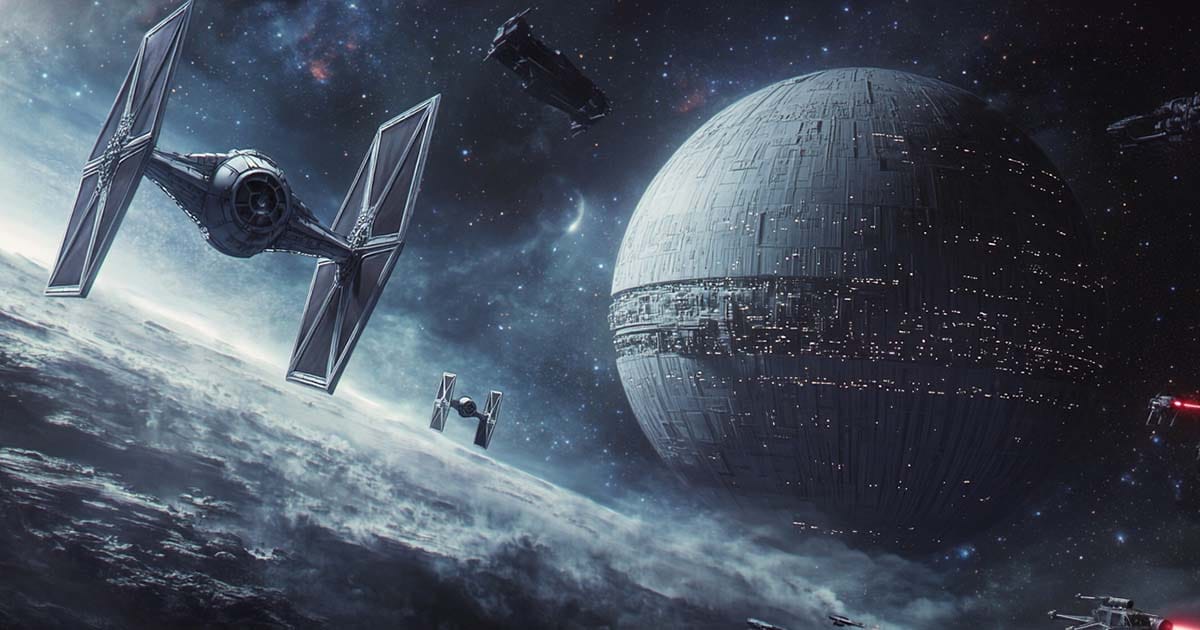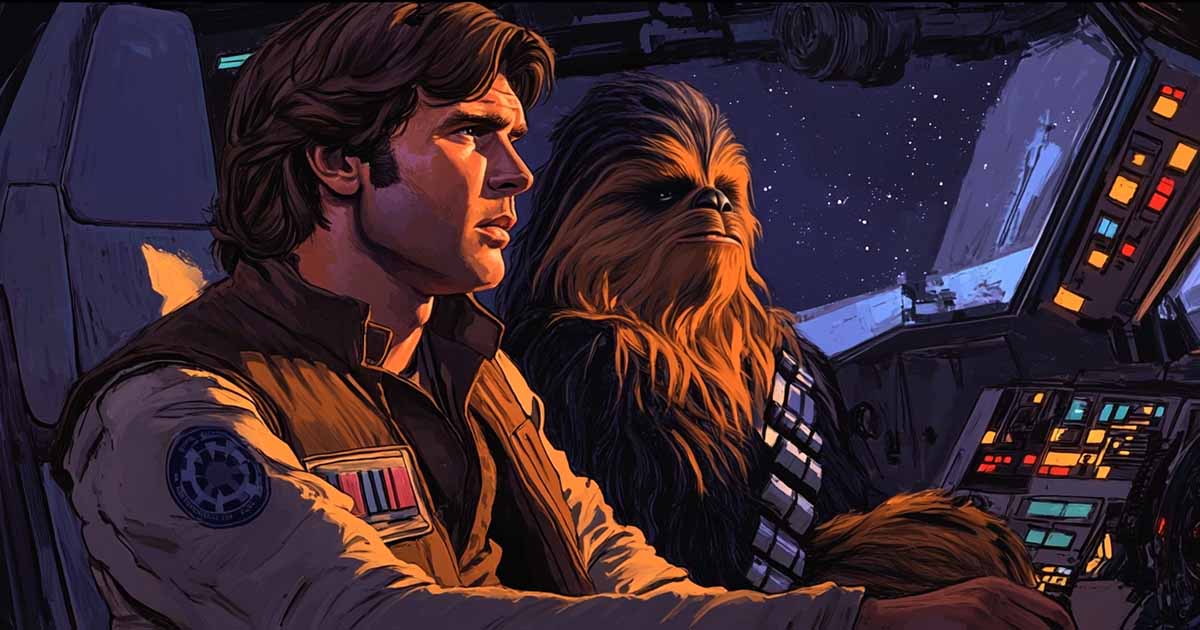What if Han Solo Never Returned to Save Luke at Yavin?
Han Solo’s choice at Yavin shaped the galaxy’s fate. Without him, Luke dies, the Rebellion falls, and the Empire reigns unchecked. Explore how "Star Wars" could have ended in darkness.

In "Star Wars," the Battle of Yavin is the moment that defines the Rebellion's survival. The Death Star, a superweapon capable of annihilating entire planets, closes in on Yavin IV, where the Rebel Alliance has gathered its forces.
The only hope lies with Luke Skywalker, an inexperienced pilot flying his X-wing down the station's trench in a desperate bid to destroy it. But he is not alone. Darth Vader —the Emperor's enforcer and Luke's father— moves in to eliminate him, flanked by two TIE fighters. With the Death Star's weapon primed to fire, Luke is seconds away from death —until Han Solo arrives at the last moment, clearing the way for Luke to take his fateful shot.
But what if Han never returned?
Without his return, Luke Skywalker remains at Vader's mercy, the Death Star is not destroyed, and the Rebellion faces near-certain annihilation.
Exploring this scenario, we can better understand Han Solo's role beyond that of a wisecracking smuggler. His decision to come back for Luke was more than just an act of friendship; it was the difference between victory and disaster. Removing that choice leads to an entirely different galaxy —one where hope may not endure.
Immediate Consequences at the Battle of Yavin
The galaxy's fate shifts when Han Solo fires on Darth Vader's TIE Advanced. His sudden attack forces Vader's fighter into an uncontrolled spin, giving Luke Skywalker the opening he needs to fire his proton torpedoes into the Death Star's exhaust port.
The station is destroyed, and the Rebellion claims its most critical victory. Without Han, however, the sequence of events changes dramatically—and not in the Rebellion's favor.
Luke's Vulnerability
Vader, an experienced pilot and master of the Force, has already locked onto Luke's X-wing. At such close range, dodging is nearly impossible. The Force may have heightened Luke's awareness, guiding him toward the final shot, but it does not make him invulnerable. He is an untested pilot, and Vader's targeting computer is moments from completing its lock. Han's attack prevents Vader from pulling the trigger. If that shot is never disrupted, there is little doubt about what happens next.
Luke's Death or Capture
If Vader fires, Luke is killed instantly, and the last hope for the Jedi dies with him. The explosion of his X-wing would be just another moment in the battle, an insignificant loss in the Empire's eyes. But if Vader exercises restraint—if he recognizes Luke's Force sensitivity—there is another possibility: capture.
It is not difficult to imagine Vader sensing something in the young pilot and choosing to take him alive. If that happens, Luke's journey to becoming a Jedi takes a darker turn. Rather than training under Yoda, he could be molded by the Emperor himself, much like his father before him.
The Death Star Remains Operational
With Luke gone, the Death Star is not destroyed. The Rebel Alliance has no backup plan. Wedge Antilles, the only other pilot still in the trench, has already pulled out due to damage. No one else is in a position to take the shot.
Within moments, Grand Moff Tarkin orders the station to fire on Yavin IV. The planet, along with the Rebel leadership, is obliterated.
At this point, the Rebellion ceases to exist as a unified force. Any surviving cells scatter, left to wage a hopeless war against an Empire that has just demonstrated its ultimate power. Without the destruction of the Death Star, the Empire's dominance becomes absolute.
Possible Last-Minute Intervention?
Would someone else have found a way to destroy the Death Star? The only remaining pilots —Wedge, Biggs Darklighter (who has already been killed), and other Red and Gold Squadron members— were never positioned for a clear shot. Unlike Luke, none had the advantage of the Force guiding them. Even if Wedge had attempted the trench run, Vader would likely have eliminated him just as quickly.
The only other possibility is an internal failure. The Death Star's exhaust port remains a critical weakness, and a delayed strike —perhaps days, weeks, or even months later— could still bring it down.
However, the Rebels would no longer have a central base from which to operate, and their remaining forces would be hunted relentlessly. The opportunity that Luke had, at the exact moment when the Death Star was preparing to fire, would never come again.
Without Han Solo's intervention, the battle ends in a complete Imperial victory. Luke is dead or captured, the Rebellion is wiped out, and the Death Star remains an unchallenged weapon of destruction. The war is over before it truly begins.
The Galactic Fallout
Han Solo's absence from the Battle of Yavin does more than seal the fate of Luke Skywalker. It erases the Rebel Alliance in a single, devastating moment. With no proton torpedoes fired and no miraculous explosion tearing the Death Star apart, Grand Moff Tarkin has no reason to doubt his station's invincibility. He gives the order, and Yavin IV is destroyed in a blinding flash of fire and debris. The battle is over, and with it, any realistic hope of overthrowing the Galactic Empire.

The Rebel Alliance Suffers a Massive Blow
The destruction of Alderaan was a demonstration of power. The destruction of Yavin IV is a death sentence for the Rebellion. The Alliance's leadership —military strategists, pilots, technicians, and political organizers— was concentrated on that moon.
Leia's Fate
Leia Organa, one of the last key leaders of the Rebellion, almost certainly perishes in the blast. Even if she manages to escape before the station fires, her options are grim.
The Death Star's victory means the Empire can tighten its grip across the galaxy without immediate threat. The loss of Yavin IV's fleet leaves her without a military force to command. If she goes into hiding, she becomes a fugitive with no organization to rally behind her. If captured, she faces execution or worse —forced servitude to the Emperor's will.
Leia's survival, however unlikely, would not be enough to rebuild what was lost. She was a warrior and a strategist, but she needed allies. With Yavin IV gone, she is a leader with no army.
Vader's Standing with the Emperor
Darth Vader, often treated as a blunt instrument rather than a true leader within the Empire, suddenly finds himself in a position of unparalleled success. He has eliminated Luke Skywalker, destroyed the Rebel Alliance's stronghold, and, in the eyes of Emperor Palpatine, proven himself as the ultimate enforcer of Imperial will.
This victory grants Vader something he had never indeed possessed: unquestioned authority. He no longer needs to tolerate interference from bureaucrats like Admiral Motti or Imperial governors who fail to grasp the nature of the Force.
The Emperor may elevate him beyond his previous role, granting him greater control over the Empire's military and intelligence divisions.
This newfound power accelerates Vader's dominance in the Imperial hierarchy. With no Jedi to challenge him, no Rebel threat to distract him, and no Sith apprentice waiting in the shadows to replace him, he becomes more than just the Emperor's right hand —he becomes the most feared figure in the galaxy.
Tarkin's Role
If Grand Moff Tarkin survives the Battle of Yavin, he solidifies his position as one of the most influential figures in the Empire. The Death Star, once seen as an audacious project, is now an unquestionable success. His doctrine of rule through fear is validated. With Yavin IV's destruction, the galaxy is forced into submission.
Tarkin, a man who always viewed Darth Vader as a tool rather than an equal, likely continues to play a key role in Imperial policy. The Death Star does not become a lost relic but an enduring symbol of control, used to extinguish dissent before it can spread. With the Rebel Alliance gone, there are no limits to his authority.
However, Tarkin's continued influence depends on whether Palpatine sees him as an asset or a threat. With Vader rising in status and Palpatine's nature as a Sith dictating that power should not be shared indefinitely, it is possible that Tarkin's reign is cut short —not by Rebels, but by the very Empire he helped build.
A Galaxy Without Rebellion
The destruction of the Death Star was a moment that defined the Galactic Civil War. Without it, the war never truly begins. The Rebellion is shattered, its leaders are dead or in hiding, and the Empire rules unchallenged. The question is no longer how the Rebels will strike back —it is whether resistance can survive at all.
Han Solo's Alternate Path
Han Solo's decision to turn the Millennium Falcon around and rejoin the Battle of Yavin was not just a tactical maneuver —it was the defining moment of his character arc. Before that, he was a self-serving smuggler who valued his survival over any cause. He took his first step toward something greater by saving Luke Skywalker and helping destroy the Death Star. Without that moment, Han remains unchanged, and his future unfolds along a very different path —one that likely leads him far from the Rebellion's fight.

Han's Personal Arc is Disrupted
When Han leaves Yavin IV, his motivations are simple: get paid and get away. His parting words —"May the Force be with you"— sound more like a polite farewell than a personal conviction. Luke and Leia see potential in him, but Han himself does not. He has spent his life outrunning debts and avoiding causes. The last thing he wants is to be tied to an idealistic war against the Empire.
A True Mercenary
Han never fully commits to the Rebel cause without his moment of redemption. He does not become the man who leads a strike team to Endor, who stands alongside Leia as a trusted commander, or who risks everything to help bring down the Empire. Instead, Han remains a drifter, taking jobs where he can, staying ahead of bounty hunters, and avoiding entanglements.
The Empire's victory at Yavin likely makes his life even more difficult. With the Death Star intact and the Rebellion crushed, Imperial control expands, cutting off smuggling routes and making illegal operations far riskier. Han is already a wanted man, but now there are fewer places to hide. The Empire no longer tolerates minor criminals; its focus on stamping out resistance leaves little room for smugglers to operate in the open.
Jabba the Hutt's Bounty
One problem that never goes away is Jabba the Hutt. Han's debt remains unpaid, and now that he has no Rebel allies to turn to, his options are limited. He could attempt to settle the debt by making another high-risk Kessel Run, but one wrong move could mean death. The alternative is going into hiding —disappearing into the Outer Rim, avoiding the major hyperspace lanes, and trying to stay ahead of the bounty hunters Jabba will inevitably send after him.
If Han returns to Tatooine, the meeting with Jabba won't go in his favor. Without the Rebellion's growing influence, Jabba has little reason to negotiate. He either forces Han into servitude or kills him outright. If Han runs instead, his life becomes an endless chase, with no cause to fight for and no future beyond the next smuggling job.
The Jedi and the Force: A Different Future
The destruction of the Jedi was nearly complete by the time of the Battle of Yavin. Obi-Wan Kenobi and Yoda, the last remnants of the old order, placed their hopes in Luke Skywalker, believing him to be the one who could bring balance to the Force and defeat the Sith. But without Han Solo's intervention, Luke never fires his torpedoes, never destroys the Death Star, and never fulfills that destiny.
His death or capture at Yavin changes more than just the fate of the Rebellion. It alters the trajectory of the Force itself, leaving the galaxy without a champion to oppose the darkness.
The Loss of Luke Skywalker
Luke's death represents the final failure of the Jedi Order. Obi-Wan had already sacrificed himself, trusting that Luke would continue the fight. Yoda, hidden away on Dagobah, waited for the moment when Luke would be ready for training. But without Luke, there is no heir to that legacy. The boy meant to restore the Jedi instead dies before his journey can truly begin.

Palpatine's Unchecked Reign
The outcome may be even worse if Luke is captured rather than killed. Darth Vader sensed his strength in the Force.
With no Jedi threat remaining, Emperor Palpatine rules without opposition. His vision of the Sith's dominance over the galaxy is realized. The Death Star ensures that no world dares rebel, and Vader, now unquestionably loyal, crushes any resistance that emerges.
One of the greatest threats to Palpatine's rule in the original timeline was Vader's divided loyalty. Luke represented an alternative path for Vader, an opportunity to overthrow the Emperor and reclaim his humanity. With Luke on the Dark Side, there is no alternative.
Over time, the Sith's power only grows. Palpatine may take on additional apprentices, ensuring that his rule extends beyond his own lifespan. With no Jedi to restore balance, the dark side dominates the galaxy indefinitely.
A Galaxy Forever Changed
Han Solo's decision to return at the Battle of Yavin was more than an act of heroism —it was the moment that determined the fate of the galaxy. Without his intervention, Luke Skywalker dies or is captured, the Death Star remains intact, and the Rebellion is annihilated before it can become a true threat to the Empire. The Jedi fade into history, and Palpatine's reign continues unchallenged, with Darth Vader serving as his unquestioning enforcer. The spark of hope that ignited a galactic uprising is snuffed out before it can burn.
The alternate future outlined here is not just a bleak one —it is a testament to the weight of individual choices. Han Solo was not a Jedi. He was not a Rebel. He had no prophecy tied to his name. Yet his decision, made in a single moment, shaped the destiny of countless lives. Without him, the "Star Wars" saga ends in darkness, a tale of a rebellion crushed and a tyranny unchallenged.
At its core, "Star Wars" is about how individuals —often reluctant, often imperfect— can make a difference. Han Solo was not destined to be a hero, but he became one by choice. His return at Yavin was not just about saving Luke; it was about defying cynicism, about standing for something greater than himself. The galaxy is changed not by fate, but by the decisions of those willing to fight for a better future.

